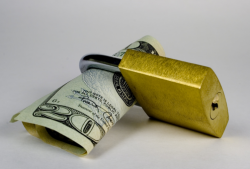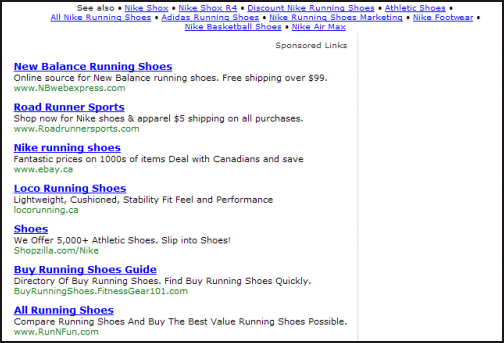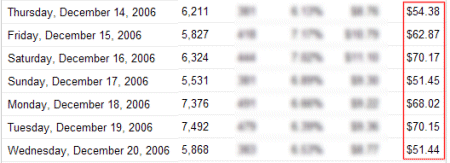Here's a pay-per-click question posted by Steve that I think many NPT readers can relate to…
Dear Rosalind,
I purchased the Super Affiliate Handbook about 10 months ago and have been really applying myself with several affiliate offers. Your book was so helpful, and I have gone from having no clue about how to build a website to learning HTML, CSS, PPC, SEO and all of that good stuff.
However at the moment I am feeling extremely discouraged and really don't know where else to turn for help. Here's why:
Every time I use Pay Per Click I get killed. The math just doesn't work.
For Example, I am trying to market a popular weight loss product from Clickbank. It has a gravity of 747 so it's obviously selling, and it pays $26.30 per sale. My problem is that the PPC is way too expensive to turn a profit. If an average affiliate converts at 1% that means I have to get clicks for $0.26 to break even. This is simply not possible. Lets assume my landing page is very good and this product could convert at 3%. Then I break even with $0.79 clicks.
I have found one keyword with slow but steady traffic on Yahoo that I can get position 4 for $0.42. Using this keyword as an example, with a 3% conversion rate, I spend $42 on clicks to turn a $36.90 profit. This works, but I will be 86 years old before I make five sales at this rate! 🙂 I need lots more cheap keywords to get any significant traffic volume and, well, they're all over $1 per click! The cheap keywords seem to have no traffic volume.
If the Clickbank gravity is over 700 then this thing is selling like hot cakes. What am I doing wrong? If you wouldn't mind offering some advice I would really appreciate it!
Best Regards,
Steve Anderson
OK, because Steve didn't provide a link to the landing page for this particular PPC campaign, here's my general take on the situation, as well as a solution.
First of all, weight loss is a HUGE market that's increasing in size every day. That's a good thing for marketers.
However, because the diet / weight loss niche is so popular, you have tons of competition from other marketers and pay per click keyword prices skyrocket, as Steve indicated.
That doesn't mean you can't make a profit using ppc advertising to big markets with tons of competition. I personally love playing in big markets.
But you have to play it smart.
And by ‘smart' I mean that each of the following 3 elements has to be absolutely perfect.
- Your Ad Copy.
- Your PPC Bid and Ad Position.
- Your Landing Page.
Although I can't write an entire course here on copywriting, bid positioning and landing page copy and construction – I'll share the essential nuggets.
Ad Copy
First and foremost, ad content must be 100% relevant to content on the landing page. I'll talk more about that in the Landing Page section below.
Moreover, because you have tons of competiton, your ad has to stand out, so make it unique and personal. So where using “Lose Weight” in the headline will put your ad adrift in a sea of 100's of other boring “me too” ads, using “How I Lost 89 Pounds” (in quotes) sets your ad apart and makes it more noticeable. That captures the surfer's attention. They think “I want to know how he/she did that” and clicks on your ad, most without ever reading the rest of the copy.
For those that do read the description, it had better be amazing (‘amazing' is a good word to use) and enhanced with credibility (as seen on CNN) or speak to a specific timeframe. Speaking of timeframes, those ads that are still promising that you'll “look great in 2008” are dead in the water and should be revised to promise that I'll look simply fabulous in a bikini this summer. Note how the latter is more specific and conjures up a specific image — scarey as that may be?
Bid and Ad Position
NEVER bid the top spot. Lower on the first page is always better both in terms of price and overall conversion rates. People have to spend more time filtering through the top ads to get to the lower regions of the Sponsored Listings, so they prove that they're more motivated to buy product.
You also don't want to waste your time having your ad languish on the second page of ads.
Most of all, don't put your ad up on the Content Network until after you've proven that it converts.
Landing Page
I won't even bother talking about sending traffic to a merchant's landing page from a PPC ad — in most cases that's a guaranteed way to put yourself in the hole with PPC advertising. Moreover, it's a terrible business model.
As stated earlier, your landing page has to be completely relevant to the promise made in your ad. Ergo, if you say that you lost all that weight, I want to read your story, not end up on a side-by-side comparison page of your top 3 recommended weight loss products. I want to see something that looks like a real person is telling their story – not some glitzy, merchant-prepared landing page with high-end graphics that is just too obviously just another ad.
Here's a screenshot of a landing page that I did for a handbag promotion… note how it's personal? It got a 6% conversion rate on the PPC campaign.
NOTE: If you need more help with website copy, read my How to Sell WITHOUT Selling article and Ken Evoy's MYCPS! (Make Your Content PreSell) is available as a free download.
Once you have all that in place, you need to watch your campaign like a hawk. That means testing and tweaking, and testing and tweaking some more until it is converting properly.
But what if you've done all of that and it STILL doesn't convert?
The Main Reason Affiliates Lose Money on PPC!
Well, there's one more reason many affiliates still end up losing money on their PPC campaigns.
They're driving traffic to a single-product landing page that in most cases only links out to the merchant's product.
So guess what happens when the visitor decides that they're not interested in the product being promoted and doesn't visit the merchant page?
That's right. They back-up or close the page.
And that's the reason that I DON'T teach or advocate using single-product landing pages in the Super Affiliate Handbook.
That's not to say that there aren't affiliates who use this technique successfully. There are. But relatively speaking, their success rates are lower than those of us who use the content model. Moreover, they work very hard to build out each and every campaign, in some cases only producing one campaign every 3 months. Then, the law of diminishing returns comes into play when other affiliates find out about a newly successful PPC campaign and they pounce to promote the product. (See below for how they find out about those successful PPC campaigns.)
Compare that with having your visitor land on your blog and when she decides that she's not interested in pursuing the original product further, she sees that there are many more options relevant to her interests that she can peruse through links in your sidebar. So, she clicks on one of those links and because you have informative content on your site, she sticks around longer. Google likes that and gives you higher rankings for keeping your readers' interest.
She sees that you have a newsletter and because she finds your content interesting, entertaining and of such value, she decides to signup. Yippee!! You can now market to her again and again.
Lastly, of the products listed on your site, she finds one that she likes and buys it.
Amazing how that works and here's why…
We like having options.
Can you imagine wanting running shoes and ending up in a store that sold only one brand and one style of shoe? Ugh. Wouldn't you prefer to offer your visitors a nice array of products from which to choose and also have the option of selling them something even bigger — like maybe a treadmill?
Ultimately, when you have a content site, your PPC dollars go a lot farther by increasing the number of visitors who stay longer (which raises your rankings and brings MORE visitors) and you're building a list.

 Need traffic?
Need traffic? 


